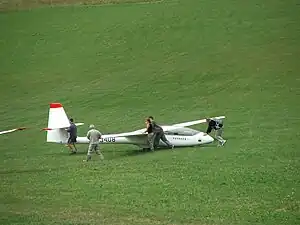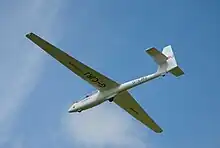PZL Bielsko SZD-50 Puchacz
The PZL Bielsko SZD-50 Puchacz (Polish: "eagle owl") is a Polish two-place training and aerobatic sailplane.
| SZD-50 Puchacz | |
|---|---|
 | |
| Role | Sailplane |
| National origin | Poland |
| Manufacturer | PZL Bielsko |
| Designer | Adam Meus |
| First flight | 13 April 1979 |
Development
The Puchacz was designed by Dipl-Ing Adam Meus based on the prototype SZD-50-1 Dromader. It was intended to serve as the successor to the popular Bocian for training. Its first flight was April 13, 1979.
Being a moderately-priced, versatile, modern two-seater with good handling qualities on the ground and in the air, the Puchacz has become a very popular two-seater sailplane in many countries both for ab-initio and aerobatic instruction.
A large number of fatal accidents involving spins have occurred with the Puchacz.[1] Investigations have failed to uncover a common design flaw, but the type's reputation has nevertheless been tainted. Its supporters point out that it was designed to obey faithfully all control inputs - including foolish ones. Partial failures at the rudder bar and control sticks have been known to occur, but Airworthiness Directives have been issued for modifications.
Description
The Puchacz is a construction protected by polyurethane paint rather than the more usual gelcoat finish. Although it is mainly glassfibre, the fuselage has two wooden frames as the connection point for the wings and undercarriage. Assembly entails inserting a single main pin to secure the wings in place and a spring-loaded locking pin for the tailplane. The air brakes open above and below the wings and are extremely efficient in comparison with other gliders, allowing very steep flight.
It has a tandem seating arrangement for the two occupants with the front seat used for solo flights. The front rudder pedals and the rear seat shell are adjustable. The front instruments are arranged so that they can be easily viewed from the rear seat; a rear instruments panel is also available as an option.
The Puchacz meets both OSTIV and JAR-22 Utility Category certification requirements and is approved for extended aerobatics including inverted flight and rolling manoeuvres.
Variants
- SZD-50-1 Dromader
- The initial design and prototype of the Puchacz series, first flown on 21 December 1976; two built.
- SZD-50-2 Puchacz
- Initial production variant first flown on 13 April 1979.
- SZD-50-3 Puchacz
- Later production standard with fin mounted 300 mm (12 in) higher, enlarged rudder and main-wheel fairing.
Specifications (SZD-50-3)

Data from Jane's All the World's Aircraft 1988-89[2]
General characteristics
- Crew: 2
- Length: 8.38 m (27 ft 6 in)
- Wingspan: 16.67 m (54 ft 8 in)
- Height: 2.04 m (6 ft 8 in)
- Wing area: 18.16 m2 (195.5 sq ft)
- Aspect ratio: 15.3
- Airfoil: NN-8
- Empty weight: 370 kg (816 lb)
- Max takeoff weight: 570 kg (1,257 lb)
Performance
- Stall speed: 60 km/h (37 mph, 32 kn)
- Never exceed speed: 215 km/h (134 mph, 116 kn) in smooth air
- 160 km/h (86 kn) in rough air
- 150 km/h (81 kn) on aero-tow
- 110 km/h (59 kn) on winch launch
- g limits: +5.3 -2.65
- Maximum glide ratio: 32
- Best glide speed: 85 km/h (46 kn; 53 mph)
- Rate of sink: 0.7 m/s (140 ft/min) *Minimum sink speed: 75 km/h (40 kn; 47 mph)
- Wing loading: 31.4 kg/m2 (6.4 lb/sq ft)
See also
Aircraft of comparable role, configuration, and era
Related lists
References
- ASN Aviation Safety Database
- John W.R. Taylor, ed. (1988). Jane's All the World's Aircraft 1988-89. London: Jane's Information Group. pp. 637–638. ISBN 0-7106-0867-5.